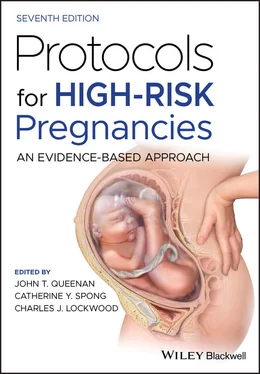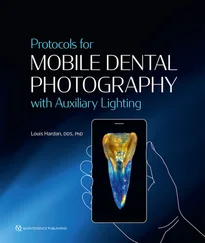Library of Congress Cataloging‐in‐Publication Data
Names: Queenan, John T., editor. | Spong, Catherine Y., editor. | Lockwood, Charles J., editor.
Title: Protocols for high‐risk pregnancies : an evidence‐based approach / edited by John T. Queenan, Catherine Y. Spong, Charles J. Lockwood.
Description: Seventh edition. | Hoboken, NJ : Wiley‐Blackwell, 2021. | Includes bibliographical references and index.
Identifiers: LCCN 2020024021 (print) | LCCN 2020024022 (ebook) | ISBN 9781119635260 (paperback) | ISBN 9781119635284 (adobe pdf) | ISBN 9781119635291 (epub)
Subjects: MESH: Pregnancy, High‐Risk | Pregnancy Complications | Evidence‐Based Medicine
Classification: LCC RG571 (print) | LCC RG571 (ebook) | NLM WQ 240 | DDC 618.3–dc23
LC record available at https://lccn.loc.gov/2020024021LC ebook record available at https://lccn.loc.gov/2020024022
Cover Design: Wiley
Cover Image: © Universal Images Group North America LLC/Alamy Stock Photo
The current acceleration in medical discoveries parallels Moore’s law for computer chips. In the 1950s, medical knowledge doubled every 50 years, by the 1980s it doubled every seven years, and now medical knowledge is estimated to double about every two months (Densen 2011). How can busy obstetricians keep pace? Through seven editions, Protocols for High‐Risk Pregnancies has helped address this exact challenge. Providing just‐in‐time content, its focus on protocols and guidelines helps organize medical thinking, avoid heuristic errors of omission and commission, and optimize maternal and fetal outcomes.
As with the prior six editions, we have once again assembled some of the world’s top obstetrical and medical experts. Concomitantly, the seventh edition adds a number of new features including protocols on opioid use, misuse and addiction in pregnancy and postpartum, noninvasive prenatal diagnosis of aneuploidy, periconceptional genetic screening, and expanded protocols on maternal valvular heart disease and cardiomyopathies; we have also added protocols on arboviruses including Zika, and malaria, to reflect new technologies, changing clinical disease patterns, and emerging global pathogens.
As in prior editions, our focus has been on conducting a comprehensive survey of recent relevant literature to extract the most current evidence‐based practices and then presenting them with concise, focused text and crystal‐clear clinical paradigms. In areas where there are reasonable clinical alternatives, where no single compelling randomized clinical trial or a clear metaanalytical preference is available, we have again asked the authors to use their best judgment to make recommendations.
We are deeply indebted to our common mentor, Dr John T. Queenan, who conceived of this text to help “clinicians in the trenches” and hope we have been faithful to his vision. We also appreciate the help of our editorial team at John Wiley & Sons, Deirdre Barry and Anupama Sreekanth.
Catherine Y. Spong, MD
Charles J. Lockwood, MD, MHCM
1 Densen P. Challenges and opportunities facing medical education. Trans Am Clin Climatol Assoc 2011; 122:48–58.
Christina M. AckermanDepartment of Obstetrics, Gynecology, and Reproductive Sciences, Division of Maternal Fetal Medicine, Yale School of Medicine, New Haven, CT, USA
Emily H. AdhikariDepartment of Obstetrics and Gynecology, Division of Maternal‐Fetal Medicine, University of Texas Southwestern Medical Center, Dallas, TX, USA
Anne M. AmbíaDepartment of Obstetrics and Gynecology, Division of Maternal‐Fetal Medicine, University of Texas Southwestern Medical Center, Dallas, TX, USA
Michal Fishel BartalDepartment of Obstetrics and Gynecology and Reproductive Sciences, The University of Texas Medical School at Houston, Houston, TX, USA
Michael A. BelfortDepartment of Obstetrics and Gynecology, Baylor College of Medicine, Houston, TX, USA
Vincenzo BerghellaDepartment of Obstetrics and Gynecology, Division of Maternal‐Fetal Medicine, Sidney Kimmel Medical College, Thomas Jefferson University, Philadelphia, PA, USA
Richard BerkowitzDepartment of Obstetrics and Gynecology, Columbia University Medical Center, New York, USA
Bonnie L. BermasDivision of Rheumatic Diseases, University of Texas, Southwestern Medical Center, Dallas, TX, USA
Rupsa C. BoeligDepartment of Obstetrics and Gynecology, Division of Maternal‐Fetal Medicine, Sidney Kimmel Medical College, Thomas Jefferson University, Philadelphia, PA, USA
Christian BrechotDepartment of Internal Medicine, Morsani College of Medicine, University of South Florida, Tampa, FL, USA
Haywood L. BrownDepartment of Obstetrics and Gynecology, University of South Florida, Tampa, FL, USA
Catalin S. BuhimschiDepartment of Obstetrics and Gynecology, University of Illinois College of Medicine at Chicago, Chicago, IL, USA
Irina A. BuhimschiDepartment of Obstetrics and Gynecology, University of Illinois College of Medicine at Chicago, Chicago, IL, USA
Elizabeth O. BuschurDepartment of Internal Medicine, Division of Endocrinology, Metabolism, and Diabetes, The Ohio State University Wexner Medical Center, Columbus, OH, USA
John ByrneDepartment of Obstetrics and Gynecology, University of Texas Southwestern Medical Center, Dallas, TX, USA
Joshua A. CopelDepartments of Obstetrics, Gynecology and Reproductive Sciences, and Pediatrics, Yale School of Medicine, New Haven, CT, USA
Mary E. D’AltonDepartment of Obstetrics and Gynecology, Columbia University College of Physicians and Surgeons, New York Presbyterian Hospital, New York, USA
Jodi S. DasheDepartment of Obstetrics and Gynecology, Division of Maternal‐Fetal Medicine, University of Texas Southwestern Medical Center, Dallas, TX, USA
Mara J. DinsmoorDepartment of Obstetrics and Gynecology, NorthShore University Health System, Evanston, IL, USA Department of Obstetrics and Gynecology, Pritzker School of Medicine, University of Chicago, Chicago, IL, USA
Kerry E. DruryDepartment of Obstetrics and Gynecology, Duke University Medical Center, Durham, NC, USA
Elaine DuryeaMaternal Fetal Medicine, Department of Obstetrics and Gynecology, University of Texas Southwestern Medical Center, Dallas, TX, USA
Sarah Rae EasterDepartments of Obstetrics and Gynecology, and Anesthesiology, Perioperative and Pain Medicine, Brigham and Women’s Hospital, Harvard Medical School, Boston, MA, USA
Jerome J. FederspielDepartment of Obstetrics and Gynecology, Division of Maternal‐Fetal Medicine, Duke University Medical Center, Durham, NC, USA
Steven G. GabbeDepartment of Obstetrics and Gynecology, The Ohio State University Wexner Medical Center, Columbus, OH, USA Department of Obstetrics and Gynecology, The Ohio State University College of Medicine, Columbus, OH, USA
Henry L. GalanDepartment of Obstetrics and Gynecology, Division of Maternal‐Fetal Medicine, University of Colorado School of Medicine, Colorado Fetal Care Center, Aurora, CO, USA
Robert B. GhermanDivision of Maternal Fetal Medicine, WellSpan Health System, York, PA, USA
Afshan B. HameedDivision of Obstetrics and Gynecology, Irvine School of Medicine, University of California, Irvine, CA, USA
Читать дальше












